When most people think of Zen gardens, they think of expensive, high-end items that are out of reach for the average person. However, this doesn’t have to be the case! There are many ways to create a beautiful and relaxing Zen garden on a budget. This article will discuss some tips and ideas for transforming your space on a budget. It will also review some popular products that can help you get started. So, whether you’re looking to add a little zen to your life or want to create a peaceful oasis for yourself, read on for some inspiration!
Zen Buddhism and How It Relates to Zen Gardening
Zen Buddhism and Meditation
Zen Buddhism is a school of Mahayana Buddhism that focuses on the practice of meditation. This form of Buddhism was founded in China by Bodhidharma, and it has become an important part of Japanese culture. In Zen Buddhism, meditation is used to attain enlightenment through direct experience and insight into the nature of reality. Through consistent practice, practitioners can cultivate a state of inner stillness and gain an understanding of their own minds and how they interact with the world around them.
Zen Teachings
At the heart of Zen Buddhism are the teachings of the Buddha, which include the Four Noble Truths and Eightfold Path. These teachings emphasize that suffering is caused by attachment to worldly desires and that enlightenment can be achieved through meditation and non-attachment. Other important concepts include impermanence, emptiness, non-duality, and acceptance of all things as they are.
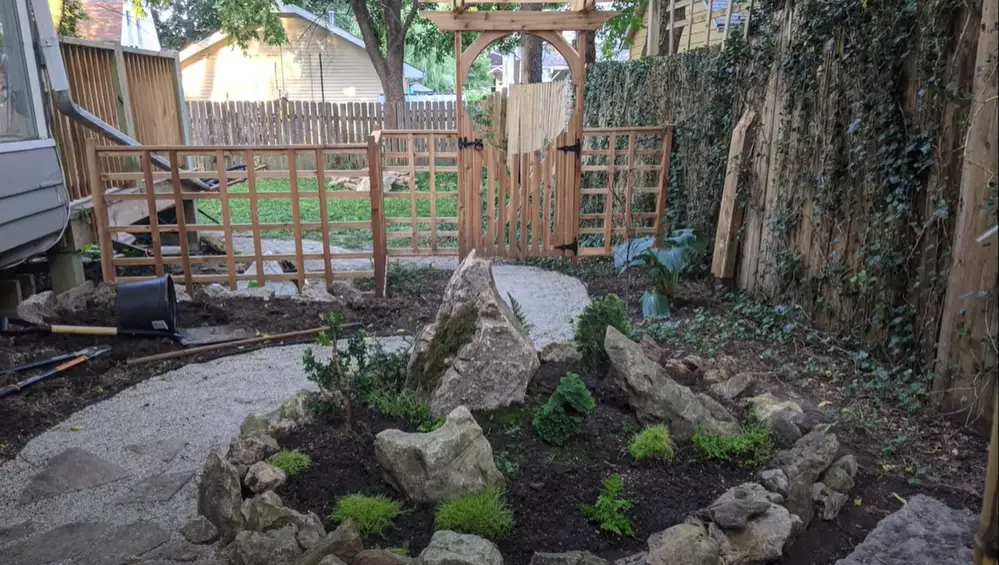
Zen Gardens
Zen gardens were developed in Japan during the Edo period (1603–1868). They are designed to create a peaceful atmosphere for contemplation and meditation. Zen gardens typically feature carefully arranged rocks or gravel with sand raked into patterns intended to promote feelings of calmness and stillness. Plants may also be included in these gardens as part of their composition. Zen gardens are meant to be experienced in the present moment, and they seek to bring us closer to our inner self by reminding us that everything is constantly changing.
Zen Gardening
Zen gardening combines aspects of both Zen Buddhism and traditional Japanese garden design. This practice focuses on creating a space for contemplation and reflection while also cultivating an appreciation for nature. The main idea behind Zen gardening is to create a peaceful atmosphere with minimal distractions so that one can meditate and focus on the here and now. To achieve this goal, many practitioners use natural elements like water, rocks, sand, plants, or moss as part of their garden designs. Additionally, these gardens often contain elements of symbolism related to Zen teachings such as non-attachment and acceptance of impermanence.
A Zen Garden’s Purpose
Zen gardens are not just beautiful decorations or an exercise in horticulture. They are designed to be places of contemplation and reflection, offering an escape from the stresses of modern life. While traditional Japanese gardens were meant to evoke feelings of awe and reverence, Zen gardens seek to create a space for peacefulness and stillness that can allow us to gain insight into our minds. By focusing on the here and now and allowing ourselves to accept all things as they are, you can cultivate inner peace which can help your live more mindful lives.
Zen Garden Designs and Symbolism
Zen gardens are often designed with careful consideration of their symbolism. Rocks can represent mountains, rivers, or other natural features while sand is used to represent the sea or a beach. The patterns created by raking sand can also be symbolic, representing waves, rivers, clouds, dragons, and many other concepts related to Zen Buddhism. Plants are sometimes used to symbolize life and growth or even enlightenment itself. By including these elements in your garden design you can create a space that is not only aesthetically pleasing but also has greater meaning and purpose [1].
You will need some or all of the below to make a Zen Garden on a budget
Make the Right Tools
To make a Zen garden on a budget, you’ll need tools that are specifically designed for making the perfect Zen garden. The most important tool is the rake. A good rake will allow you to create symmetrical shapes and keep your garden looking neat and tidy. Other tools such as shovels, pruners, hoes, and edgers can also come in handy when creating a Zen garden.
Add Sand or Gravel
Using sand or gravel is a great way to give your Zen garden an authentic look. Choose the right type of sand or gravel based on the size and shape of your garden, as well as the desired texture. For larger gardens, use a finer type of sand or gravel to create intricate patterns. If you have pets, be sure to choose a non-toxic option that won’t harm them if they come into contact with it.

Add Rocks and Pebbles
Rocks and pebbles are essential elements in creating a classic Zen garden. You can find rocks in many different shapes, sizes, and colors from your local landscaping supply store or online. Consider using several different types of rocks for added interest. Pebbles can be used to fill in any gaps and create a smooth, even look.
Add Plants
Plants are the finishing touch of any Zen garden. Choose low-maintenance plants such as succulents or herbs that won’t require too much care and maintenance. Be sure to select plants that will thrive in the environment you have created for them. For example, if you are using a lot of gravel, opt for plants that do not require much water.
Make Circles and Patterns
Once you have all the elements in place, it’s time to get creative and start creating circles and patterns. This is what makes a Zen garden unique and gives it its distinctive look. You can use your rake to create intricate designs or just keep things simple with basic circular shapes. Additionally, adding a small bridge or fountain to your garden can add an interesting touch.
Add a Bamboo Water Feature
Adding a small water feature to your Zen garden can be an enjoyable way to complete the scene. Bamboo water features are especially popular, as they add a calming atmosphere and bring in elements of nature. Be sure to choose a water feature that fits with the overall design and size of your garden.
Add a Concrete Lantern
If you want to add a special touch of elegance, consider adding a concrete lantern. This will provide your Zen garden with soft lighting in the evenings and create an inviting atmosphere. Choose a design that fits with the overall look of your garden, such as a traditional Japanese lantern or something more modern-looking.
Add a Buddha Statue
If you’re looking for a truly authentic touch, add a small Buddha statue to your Zen garden. This will provide an element of peace and serenity and make your garden even more special. Choose from a variety of different sizes and styles to fit the design of your garden. These statues can be made of stone, metal, or ceramic, and you can even find solar-powered ones.
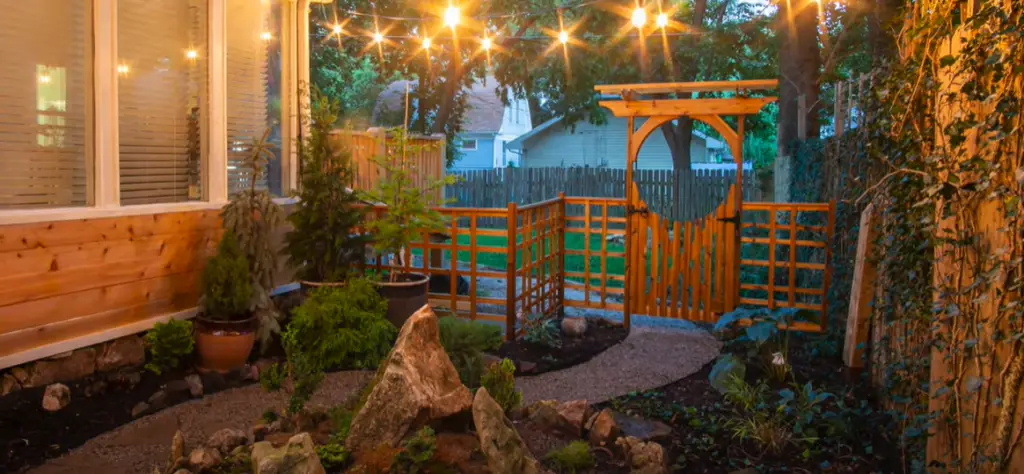
Add a Bamboo Enclosure
Bamboo enclosures are another great way to add a special touch of elegance to your Zen garden. Not only do they provide privacy and shade, but they also look beautiful. Choose from different styles and sizes that fit the size of your garden. If you live in an area with cold winters, make sure to get one that is frost-resistant so it can last for many years.
Establish a Path Over Gravel or Sand
Creating a path through your Zen garden is an important element of creating balance and symmetry. Choose from different materials such as gravel, sand, or stones to create a path that winds its way around your garden. Make sure the path follows the overall design of your garden and provides ample space for walking.
Plant a Sakura Tree
If you want to create a truly authentic Zen garden, consider planting a sakura tree. The beautiful pink flowers of the sakura tree are a symbol of renewal and joy, and they bring in elements of nature. Be sure to research how best to care for your tree so it can thrive in the environment you have created for it [2].
Zen Garden Ideas On A Budget
Keep It Simple With An Easy Water Feature
A simple water feature can be an inexpensive and attractive way to add life, color, and sound to a Zen garden. A small pond, fountain, or even a bird bath will bring a tranquil splash of water to your outdoor space. You can also add greenery such as aquatic plants in the water for extra interest.
Add Color With Container Gardening
Container gardening is a great way to add some summertime color to your landscape without breaking the bank. Choose colorful containers that fit with the overall look of your Zen garden style, then fill them with annuals or perennials depending on how much maintenance you are willing to do and what time of year it is. Some good choices include lilies, impatiens, petunias, and pansies.
Create a Zen Pathway
A path made of stones or pebbles can be a great way to lead visitors through your Zen garden. You can buy sets of inexpensive stepping stones that are easy to install and will add character to the area. If you have natural stone pavers already in your landscape, use those as well for an even more tranquil look.
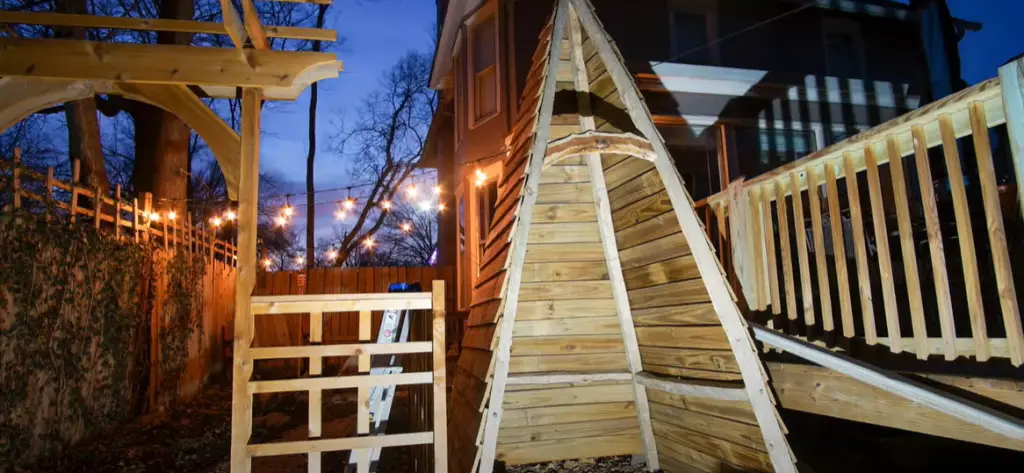
Turn A Tranquil Corner Into A Zen Garden
You don’t need a lot of space to create an outdoor oasis. Look for a corner in your yard that could be transformed into a tranquil spot with some plants and seating. Add a bench or chair, some colorful flowers, and greenery, and hang a wind chime or two for extra atmosphere.
Install A Trellis Or Arbor
Trellises and arbors are great additions to any Zen garden. They provide lovely frames for flowering vines, colors, and scents while still maintaining the landscape’s sense of peacefulness. Make sure you choose one that is strong enough to support any plants you add in the future.
Create A Simple Zen Spiral Using Inexpensive Gravel
One of the most iconic symbols of a Zen garden is the spiral pattern. This can be easily created with gravel for an inexpensive, elegant look. Simply use a stick or broom handle to draw out your spiral shape in the soil and then fill it in with either white or black gravel, depending on your color scheme. The contrast between light and dark colors can make an eye-catching design.
Create A Zen Meditation Spot In Your Garden
No Zen garden is complete without a place to sit and meditate. Find a peaceful corner in your outdoor space and add a meditation bench or cushion. Being able to spend time in nature can be an incredibly calming experience, so make sure you set aside some time each day to appreciate your tranquil spot.
Use Rocks And Sand To Create Your Zen Garden
Rocks, sand, and gravel are essential elements of a Zen garden. Use these materials to create interesting shapes in the landscape, such as circles or spirals. Sand can also be used for raking patterns that symbolize the flow of life. You can find many types of rocks and stones at your local home improvement store that will fit your budget.
Use Bamboo To Screen Off Your Zen Garden
Bamboo is an affordable and easy way to create a sense of privacy for your Zen garden. You can purchase bamboo screening or build a trellis yourself using simple materials. It will also make a great backdrop for any other features you add, such as furniture or water features.
Light Up Your Zen Garden With Solar Lights
Solar lights are not only inexpensive but they provide soft illumination that helps to set the mood in your outdoor space. Use them to light up pathways or highlight certain areas, like meditation spots or water features. This is also an eco-friendly option since solar lights don’t require electricity.
Plant A Group Of Flowering Cherry Trees
Nothing is more peaceful than looking out over a landscape of flowering cherry trees. The bright pink flowers will add color and cheer to your outdoor oasis. Look for trees that are small enough to fit in your garden, so they won’t overwhelm the space. Additionally, they are easy to maintain and require minimal pruning.
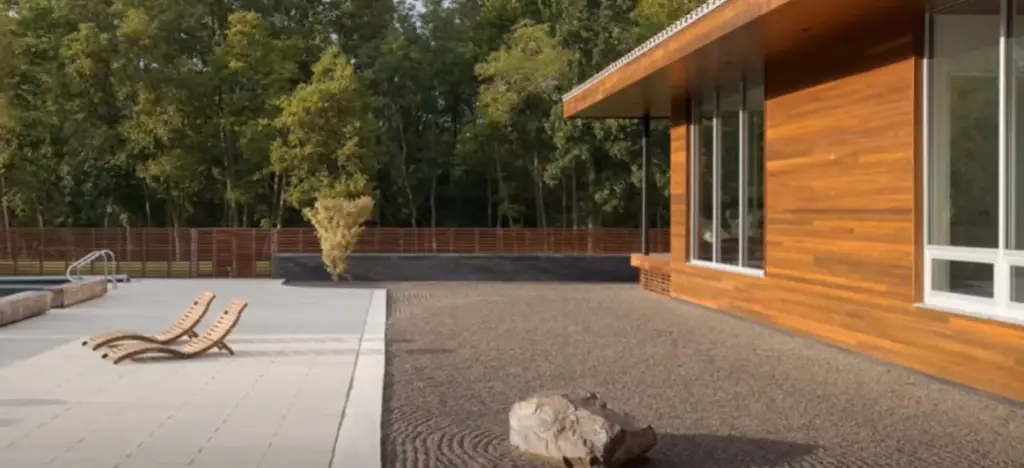
Add Colorful Perennials To Your Zen Garden
Adding a variety of colorful perennials can help to brighten your outdoor space. Perennials come back year after year and some varieties will even attract hummingbirds or butterflies, adding an extra element of life to the garden. Plant them in groups for a lush, full effect, and choose colors that complement each other for a cohesive look.
For a unique touch, plant succulents or ornamental grasses in between the flowers. These plants add texture and form while still being low-maintenance. Succulents also tolerate droughts better, so you don’t have to worry about them if you go away for a few days.
A Very Small Zen Garden Works Too
Zen gardens can be as big or small as you like. Even if you have a tiny outdoor space, you can create a peaceful Zen atmosphere with just the basics. Use rocks and sand to create simple designs that evoke a sense of serenity, add some colorful flowers for pops of color, and use bamboo to frame off your area for an extra touch of privacy.
Use Different Colored Gravels To Define Your Zen Garden
Gravel is an ideal material for defining the pathways and areas of your Zen garden. It can be used to create unique designs, such as circles or spirals, which will help to make the space feel more cohesive. You can also experiment with different colors of gravel to achieve a variety of effects. For example, white gravel will reflect light and brighten up dark areas, while dark-colored gravel can be used to define borders or create contrast against lighter stones [3].
How to maintain a Zen Garden?
Zen gardens are relatively easy to maintain and can provide a relaxing and therapeutic atmosphere. In order to keep your zen garden looking its best, it’s important to practice good maintenance practices.
The first step is to clear away any leaves or debris that may have accumulated in the gravel. Additionally, you should remove weeds as soon as they appear. If desired, a light layer of fertilizer or compost can be added to the soil for extra nourishment.
Rocks and stones should also be inspected regularly and cleaned with mild soap and water if necessary. The gravel should be raked regularly to create smooth patterns reflective of their peaceful nature.
Finally, while there is no “right” way to maintain a zen garden if any changes are made it’s important to be mindful of their impact on the overall look and feel of the garden. Taking time away from the busyness of life and simply enjoying your zen garden can be enough!
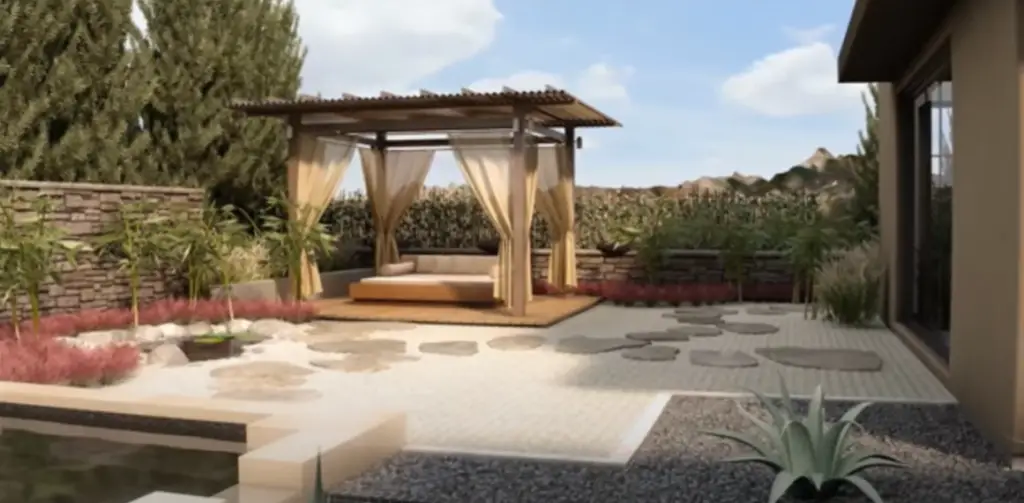
FAQ
What do you put in a Zen garden?
A Zen garden typically consists of rocks, gravel, or sand that is raked to represent the flow of water, along with carefully arranged plants and sometimes a few statues. Other elements may include lanterns, bridges, and stepping stones. All these elements are meant to bring peace and relaxation to your outdoor space while also creating an inviting atmosphere for contemplation and reflection. The exact components used in a Zen garden will depend on your taste and the size of your outdoor space. By combining different elements in interesting ways you can create a beautiful and calming area for yourself or others to enjoy.
What types of materials should I use in my Zen garden?
The type of material used in a Zen garden will largely depend on the size and style of the garden you are aiming for. Common materials used in Zen gardens include gravel, sand, rocks, wood chips, and small plants or shrubs. For larger gardens, larger rocks and statues can be used to create a more dramatic effect. Regardless of the materials you choose, it’s important that they are chosen carefully and placed thoughtfully so that they convey the desired aesthetic effect.
How do I maintain my Zen garden?
Maintaining a Zen garden is fairly easy as long as you stay on top of it. Be sure to rake the gravel or sand regularly to keep it looking neat and free of debris that may have blown in from the wind or been tracked in by animals. You should also check your plants regularly to make sure they are healthy and trim any that are overgrown. Finally, be sure to keep the area around your garden free of weeds or other unwanted plants. Doing these things will help ensure that your Zen garden remains a peaceful and inviting place for as long as possible.
What are the three types of Zen gardens?
The three most common types of Zen gardens are the dry garden, the stone garden, and the courtyard garden. The dry garden is made up mostly of sand and rocks that are raked to represent the flow of water, along with a few plants or shrubs for color and texture. The stone garden consists primarily of large stones or boulders arranged aesthetically often surrounded by gravel or sand. Finally, the courtyard garden is usually placed outside a home or building and typically contains small trees and bushes as well as some rocks or statues. All three types of gardens can be used to create a peaceful atmosphere and provide a nice place for contemplation and relaxation.
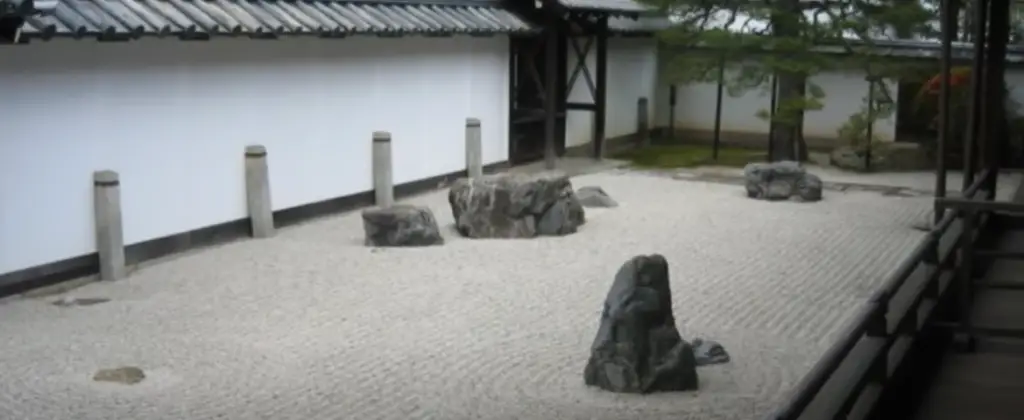
What are the eight elements of a Zen garden?
The eight elements of a Zen garden are rocks, gravel or sand, plants, statues, lanterns, bridges, stepping stones, and water. Each one of these elements can be used to create an inviting atmosphere for contemplation and relaxation. Rocks can be placed in interesting patterns and gravel or sand can be raked to represent the flow of water. Plants bring a natural element to the garden while statues provide more of a decorative touch.
Lanterns help set the mood and brighten up dark corners while bridges give visitors easy access to different sections of the garden. Stepping stones add texture while also giving you places to sit and relax. Finally, an element of water whether in the form of a pond or fountain adds life and movement to your garden.
What do the circles mean in a Zen garden?
In a Zen garden, circles often stand for harmony and unity. Circles are typically used to represent the balance between different elements such as earth and sky or yin and yang. They can also be used to convey a sense of eternity and timelessness in the landscape. By combining different elements in interesting ways you can create an inviting atmosphere for contemplation and relaxation. In addition, circles found in some Zen gardens may represent ripples from a stone that has been thrown into water – symbolizing the idea of impermanence.
What are the symbols in a Zen garden?
In addition to circles, other symbols commonly found in Zen gardens include dragons, lotus flowers, and koi fish. Dragons are often used as a symbol of strength and power while the lotus flower represents purity, enlightenment, and transformation. Koi fish typically symbolize good luck and fortune but can also be used to represent perseverance and determination. Other symbols that may appear in Zen gardens include cranes which represent longevity and turtles which stand for wisdom. No matter what symbols you choose for your garden, make sure that they convey the mood you’re trying to create so that visitors can appreciate their beauty and meaning.
Useful Video: Zen Garden Ideas on a Budget
Conclusion
Zen Gardens provide a tranquil, calming atmosphere that can be used for meditation and reflection. Although the creation of Zen Gardens has evolved over time, their essential elements remain the same: rocks, gravel, trees, and plants. These elements combine to create an environment that is conducive to contemplation and lessening stress. Above all else, Zen Gardens remind us to appreciate our beautiful earth – one rock at a time.
References:
- https://newskillsacademy.co.uk/blog/zen-buddhism-relates-zen-gardening
- https://freshpatio.com/zen-garden-ideas-on-a-budget/
- https://growyouryard.com/zen-garden-ideas-on-a-budget/





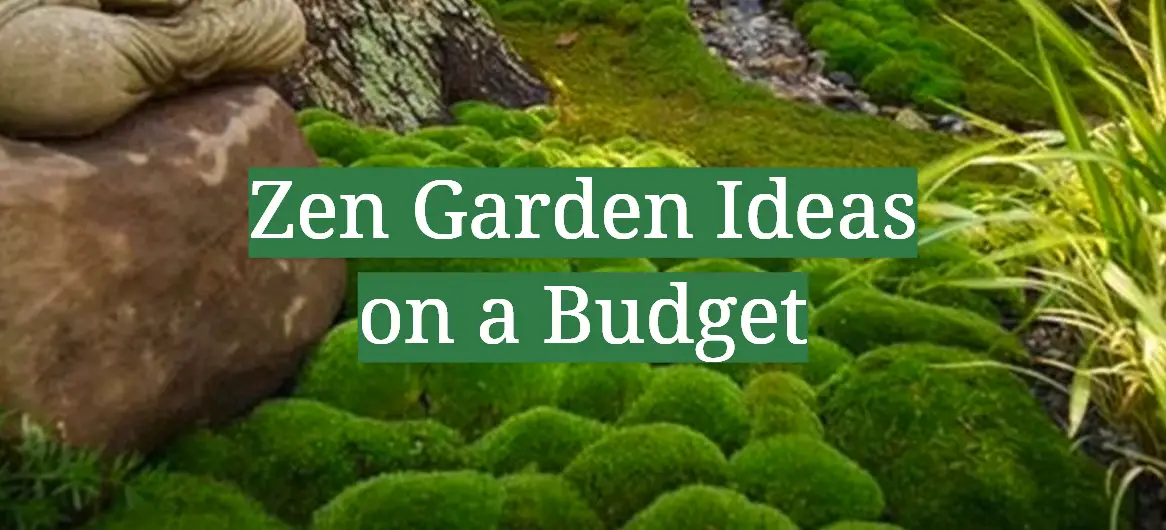




Leave a Reply
View Comments